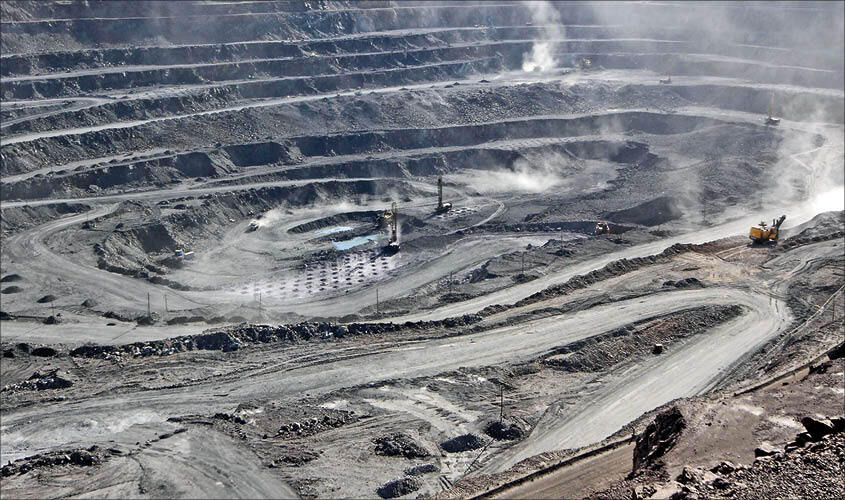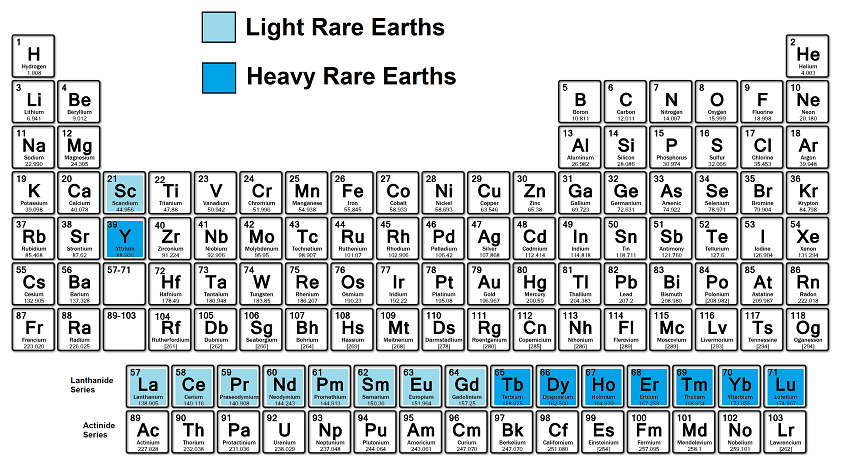Rare Earth Elements, Mining

Listen to this Article
Recently in the news there has been a lot of talk about Rare Earth Elements. These Rare Earth Elements are Rare Earth Metals that are classified primarily on the periodic table as lanthanoids. There are a couple other elements (scandium and yttrium) which are also considered Rare Earth Elements. Atomically they are lighter but are generally included due to their similar properties.
There are two main types of Rare Earth Metal classifications (Light and Heavy).

The Light Rare Earths: Scandium, Lanthanum, Cerium, Praseodymium, Neodymium, Promethium, Samarium, Europium, and Gadolinium (light blue on the table above)
The Heavy Rare Earths: Yttrium, Terbium, Dysprosium, Holmium, Erbium, Thulium, Ytterbium, and Lutetium (darker blue in the table above)
Light Rare Earths are generally more prominent in the earth's crust than the Heavy Rare Earths, and as the terms implies the "Light" Rare Earths have molecular weights that are lighter than their "Heavy" counterparts.
The question is often asked: Are Rare Earth Elements actually rare? Generally speaking, most Light rare earths are quite abundant, however some are not geographically found in many countries. The United States was the world's dominant rare earth metal ore producer from the mid 1960's through the mid-1980's . The Mountain Pass mine in California (located about 50 miles southwest of Las Vegas, NV) and up until the mid 1980's was producing annually about 23,000 tons of rare earth oxides. The Mountain Pass facility continued to produce rare earth oxides until 1998 when the separation plant was taken offline. China as of the early 1990's has been the primary separator of rare earth oxides, with the most of the mining operations occurring at the Bayan Obo mine in Inner Mongolia. Other smaller mining operations exist in Australia, and there is a lot of work going on around the globe to find other locations for these ores. Rare Earth Elements are talked about a lot in the news, due to their importance to many industries, however Neodymium (the one used the most in NdFeB Magnets), is still only found in a few locations.
The main rare earth-bearing minerals include bastnäsite, monazite, and xenotime.
Bastnäsite is a major source of light rare earth elements (LREEs).
Monazite and xenotime contain both LREEs and heavy rare earth elements (HREEs).
Below are some common uses of the LREE and HREE's.
Light Rare Earth Elements (LREEs)
| Element | Common Uses |
|---|---|
| Scandium (Sc) | Lightweight aerospace components, sports equipment (like baseball bats, bicycle frames), solid oxide fuel cells |
| Lanthanum (La) | Camera and telescope lenses, hybrid vehicle batteries (nickel-metal hydride), petroleum refining catalysts |
| Cerium (Ce) | Glass polishing, catalytic converters, self-cleaning ovens, fuel additives |
| Praseodymium (Pr) | High-strength magnets, aircraft engines, coloring glass and ceramics |
| Neodymium (Nd) | Strong permanent magnets (NdFeB magnets), hard drives, wind turbines, headphones |
| Promethium (Pm) | Radioisotope thermoelectric generators (limited use due to radioactivity), luminous paint |
| Samarium (Sm) | Samarium-cobalt magnets, neutron absorber in nuclear reactors, specialized optical and infrared equipment |
| Europium (Eu) | Red and blue phosphors in TV and LED screens, anti-counterfeiting features in Euro banknotes |
| Gadolinium (Gd) | MRI contrast agents, neutron shielding in nuclear reactors, data storage, specialty alloys |
Heavy Rare Earth Elements (HREEs)
| Element | Common Uses |
|---|---|
| Yttrium (Y) | LEDs, superconductors, cancer treatment (radiotherapy), phosphors for color TV and monitors |
| Terbium (Tb) | Green phosphors in lighting and displays, solid-state devices, magneto-optical storage |
| Dysprosium (Dy) | Enhances magnets for high-temperature resistance, electric vehicle motors, nuclear reactor control rods |
| Holmium (Ho) | Laser systems (e.g., medical lasers), nuclear reactors (control rods), magnets |
| Erbium (Er) | Fiber-optic communication (erbium-doped fiber amplifiers), lasers for medical and dental applications, pink glass coloring |
| Thulium (Tm) | Portable X-ray machines, lasers, rare applications in nuclear reactors |
| Ytterbium (Yb) | Fiber lasers, atomic clocks, stainless steel alloys, earthquake sensors |
| Lutetium (Lu) | PET scan detectors, catalysts in petroleum refining, advanced cancer treatment (Lu-177 radionuclide therapy) |
Rare Earth Permanent Magnets use a mix of the following elements: Neodymium, Samarium, Praseodymium, and sometimes Dysprosium or Terbium to increase coercivity.
The three most common magnetic alloys utilizing Rare Earth Metals are NdFeB and SmCo.
Nd2Fe14B - This is the most cost-effective rare earth magnet and the strongest variety.
SmCo5 (SmCo1:5) - Slightly more corrosion resistant but has lower strength and temperature tolerance.
Sm2Co17 (SmCo2:17) - Most recent version with higher strength and higher working temperature.
As of early 2025 China is nearly the exclusive refiner of the Rare Earth Ores/Oxides. China currently produces an excess of 90% of the worlds rare earth magnets. The local mining operations in Inner Mongolia give China a current advantage, as they have the largest mining operations, as well as oxide separations, metal refining, and final magnet production.
Amazing Magnets currently produces 100% of our NdFeB rare earth magnets in China. We are constantly evaluating additional manufacturing resources as they become available. As the demands for NdFeB magnet continue to rise, we will continue to provide best-of-class magnets with best-in-class service and support.
